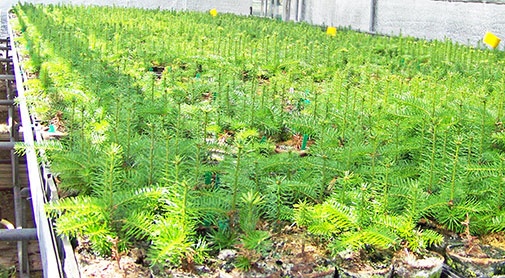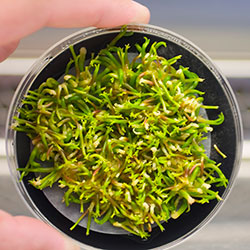Cloned Christmas trees can help reduce pesticide use
A new method makes it possible to clone Nordmann firs – the Danes’ Christmas tree of choice. Robust, beautiful trees can now be grown without pesticides or any other form of chemical treatment used to help regulate tree shape. In other words, Christmas tree farming may just become more eco-friendly.

Cloned Nordmann fir. Photo: E. Bihrmann. Download press photo by clicking on the photo.
University of Copenhagen researchers have developed a method for the vegetative propagation of the Nordmann fir. First, plant cells are stimulated to produce tiny embryos in the laboratory. These embryos are then divided a few more times until a large quantity of embryos, all with the inherited traits of the mother plant, has been produced. These are then matured and sprout in the same way as normal plants would from seed.
Jens Find, an associate professor and the head of the Tissue Culture Laboratory at the University of Copenhagen’s Department of Geosciences and Natural Resource Management, has spearheaded the project. He explains that work on this project began 25 years ago, but that only now is it ready for commercial implementation.
“The tiny embryos used to be too weak to survive. You can almost compare it with the special attention required to care for a premature baby. In recent years, we have become so good at managing the process that we are now able to produce plants which are more or less the same as those that come naturally from seed.”

Embryos. Photo: E.Bihrmann. For press photo click on the photo.
In collaboration with a grower, the small Nordmann trees have now been planted in fields. The aim is to see how they fare, and to discover among the many clones tested which ones have the properties that are vital for Christmas tree production down the road. In particular, tree appearance and resistance to insects and fungal diseases are key. According to Jens Find:
“The use of artificial embryonic propagation may indirectly result in growers reducing their use of pesticides and other chemicals. In short, we can produce trees that have a natural resistance to insects. And, they won’t require other forms of alteration to grow into beautiful trees.”
|
Artificial propagation of embryos The artificial propagation of embryos can be used to produce Christmas trees and other useful tree species. Similar methods are being used with Sitka spruce in Denmark. Sitka is a fast growing conifer that can be grown in poor soil. This makes it particularly well suited for biofuel production. The method can also be used as a foundation for selecting and culturing types of trees to be improved in relation to their importance for products such as paper, biofuel or for fibres that can be used to replace plastics. |
For more information: Jens Find, Associate Professor and head of the Tissue Culture Laboratory, jensf@ign.ku.dk, tel. +45 5148 9403
Topics
Contact
Jens Find
Associate Professor and head of the Tissue Culture Laboratory
E-mail: jensf@ign.ku.dk
Tel.: +45 5148 9403
